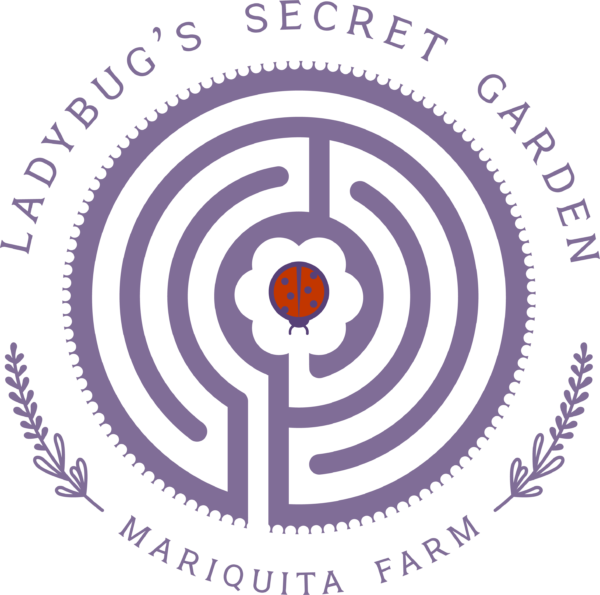Letters From Andy
Ladybug Letters
Fun Facts for the Vegetable Literate
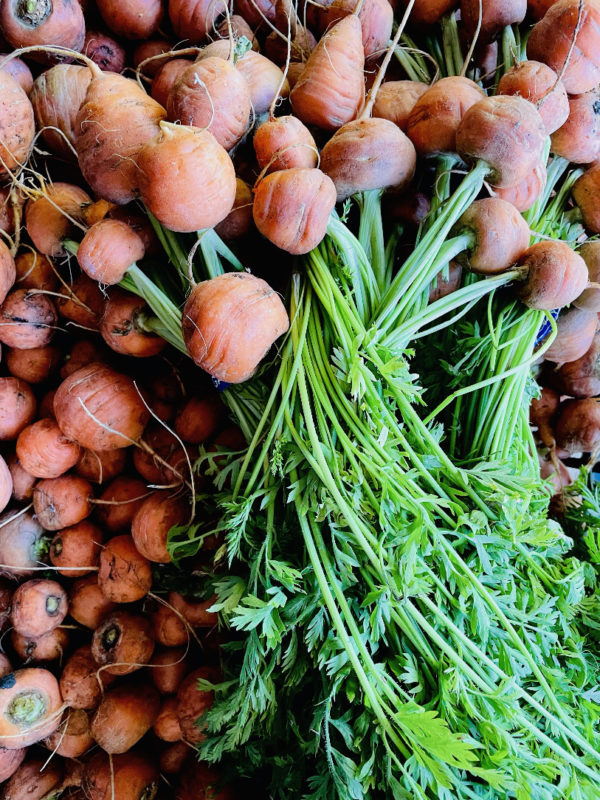
“FAQs” are “frequently asked questions,” and the reason they are frequently asked is because EVERYBODY wants to know the answers. Amaze your friends with your produce fluency by arming yourself with these fun facts!
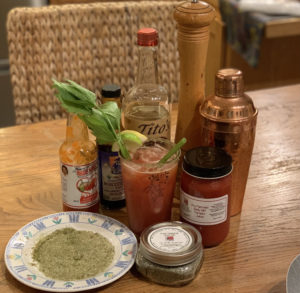 Lovage is a member of the Umbelliferae- the carrot family- along with parsley, celery, cilantro, chervil, dill, fennel, anis, and cumin. Like its relatives, Lovage has a strong scent. And lovage is often used as a garnish the way so many of the other Umbelliferae are. I joke that a single bunch of lovage has as much flavor as a whole case of celery, And the flavor of lovage certainly is reminiscent of celery, but it’s a lot stronger; little goes a long way, but it does go well with tomatoes. If you read the small print on a can of V8 juice you’ll see that lovage is an ingredient. Lovage is also a good ingredient for tomato sauces and soups. Lovage even has a role in the execution of a perfect Bloody Mary. That piece of celery often found cluttering up a Bloody Mary? – the most original of all Bloody Mary recipes called for the drink to be sipped through a lovage straw. Lovage stems are hollow, and to sip the drink through a fresh cut stem imparts just enough of the herb’s warming flavor to compliment the tomato cocktail without overwhelming it, whereas celery is just a stick of irrelevant roughage. Because we’re so rich with ripe tomatoes right now – and tomato juice and crushed, jarred tomatoes, it seems like a good time to pick some lovage.
Lovage is a member of the Umbelliferae- the carrot family- along with parsley, celery, cilantro, chervil, dill, fennel, anis, and cumin. Like its relatives, Lovage has a strong scent. And lovage is often used as a garnish the way so many of the other Umbelliferae are. I joke that a single bunch of lovage has as much flavor as a whole case of celery, And the flavor of lovage certainly is reminiscent of celery, but it’s a lot stronger; little goes a long way, but it does go well with tomatoes. If you read the small print on a can of V8 juice you’ll see that lovage is an ingredient. Lovage is also a good ingredient for tomato sauces and soups. Lovage even has a role in the execution of a perfect Bloody Mary. That piece of celery often found cluttering up a Bloody Mary? – the most original of all Bloody Mary recipes called for the drink to be sipped through a lovage straw. Lovage stems are hollow, and to sip the drink through a fresh cut stem imparts just enough of the herb’s warming flavor to compliment the tomato cocktail without overwhelming it, whereas celery is just a stick of irrelevant roughage. Because we’re so rich with ripe tomatoes right now – and tomato juice and crushed, jarred tomatoes, it seems like a good time to pick some lovage.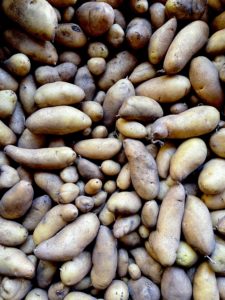 a potato with DNA from a banana?”
a potato with DNA from a banana?”Glimpses of Late Summer
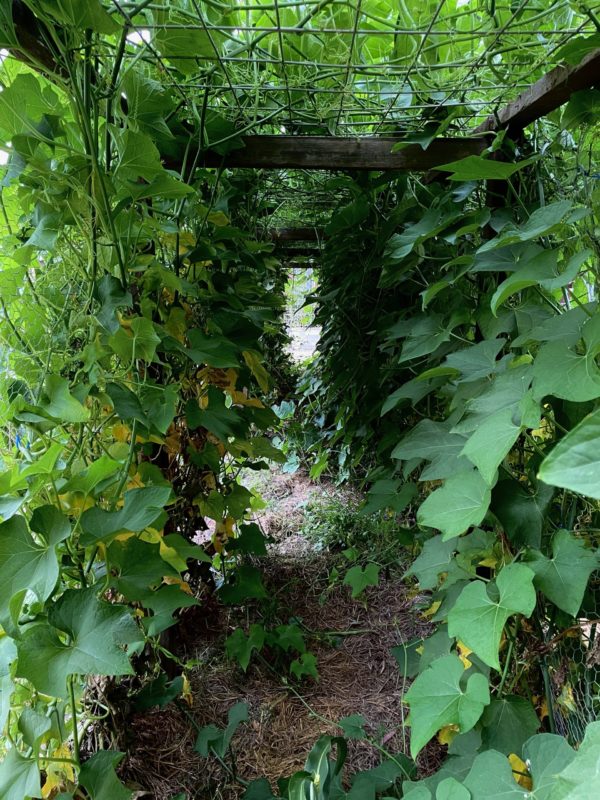
Late summer is an especially busy time on the farm, with harvesting summer crops, and planning and planting for the winter, going on at the same time. Here are a few glimpses of the changing harvests and colors on the farm.
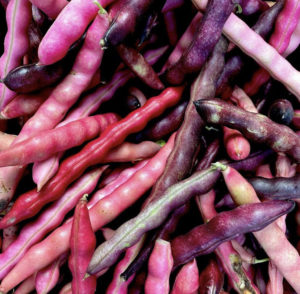
Red Oaxacan Beans
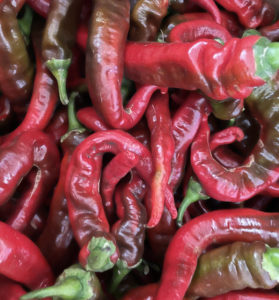
Jimmy Nordello Peppers, Sweet not Hot!
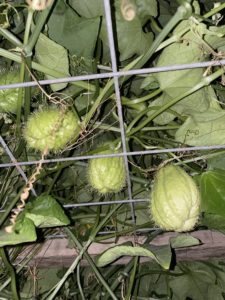
First Ripening Chayotes hanging down from Roof of Frame
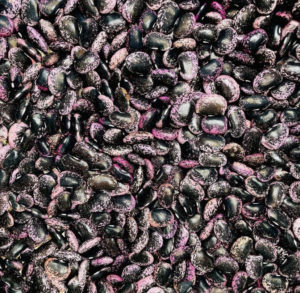
Scarlett Runner Beans
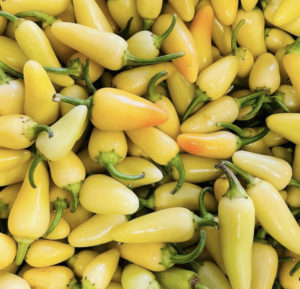
Yellow Tusta Peppers—
–© 2021 Photos by Andy Griffin and Starr Linden.
Fall Comes Dancing In!
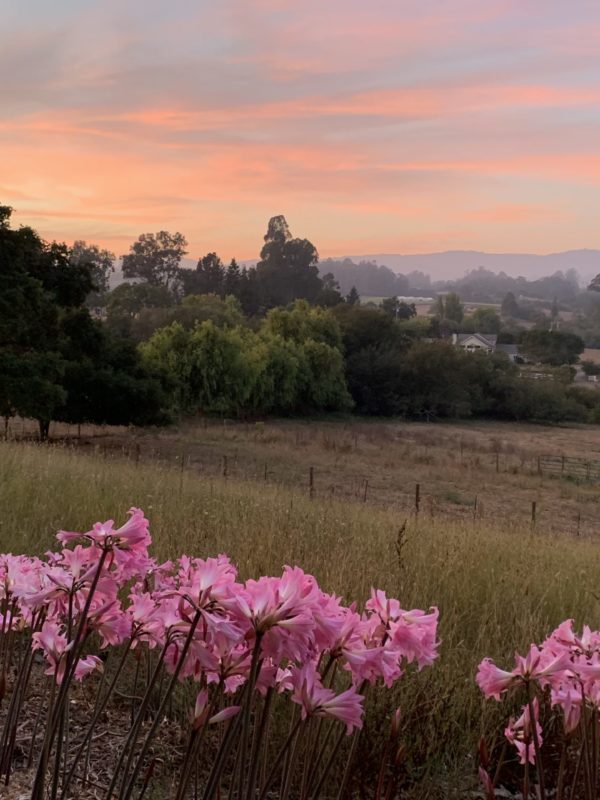
Our yard is full of “Naked Ladies.” Or you may know them as “Pink Ladies.” Their name in Botanical Latin is Amaryllis belladonna- “belladonna” meaning “beautiful woman” in Latin. These flowers shoot up like flamingo-colored signal flares from bulbs buried in the hard, dry dirt of late summer and announce the onset of fall. I welcome the sight and scent of these voluptuous creatures and they remind me of my childhood.
My father was a botanist who specialized in native California ecology. We lived in an old ranch house in upper Carmel Valley that had rows of these flowers planted outside. Dad told me that the Naked Ladies were originally from South Africa and that they’d originally been imported into the US in the late 19th century and were much appreciated by gardeners at the time. The overwhelming, sweet scent and almost lurid colors were in sync with the overblown Victorian mentality of the era. Since the Amaryllis bulbs are so hardy the plants can persist for years with no care. My dad taught me to look for seemingly stray patches of these flowers in the woods. “When you see these flowers out in the middle of nowhere,” he used to say, “you know there was once a homestead with a gardener.” We’d look around in the grass and sometimes find the bricks of a broken chimney or the outlines of an old foundation.
Our house is newer but my family has been on this property for over a 100 years. The Amaryllis here were planted by my great Grandfather. But as much as these plants are a signpost to the past, they also act as a prompt to remind me of how much work I’ve got to do now. The Amaryllis always bloom here in the first week of September. We’ve got the heaviest harvests of the season to gather, the dry weather means we have plenty of irrigation to do—- and we’ve got the fall plantings to get into the ground. The crops we plant now are the harvests that we’ll make from November thru March. So we’re really busy now and crops are getting planted almost every day of the week. Romanesco cauliflower is in the ground for later in the fall, as is broccoli. Beets and radish are going in this week as soon as the oldest plantings of basil are turned under.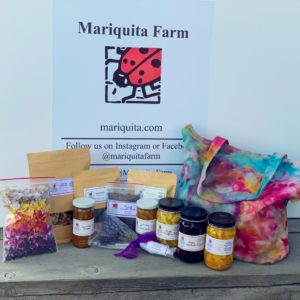
The lovely photo of Naked Ladies in our yard was taken by Starr’s niece, Jenn, who is visiting from the midwest and helping Starr compose and package the gift boxes of preserves and dried herbs that we’ll be offering in mid October as we head into the holiday season.
—© 2021 Essay by Andy Griffin. Photo of Naked Ladies by Jenn and photo of Gift Bag by Starr Linden.
Gobble, Gobble!
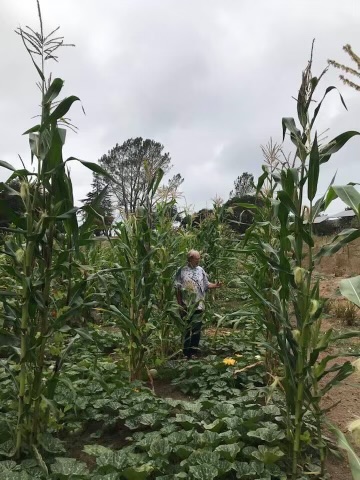
The only turkey bird native to California, Meleagris californica, went extinct 10,000 years ago. The wild turkeys that presently…
choose your own verb to insert into this sentence from the following list:
a. plague
b. ornament
c. desecrate
d. populate
e. despoil
f. violate
g. enrich
….California, are not from here at all. Heck, they are not even from Turkey! Turkeys were domesticated from the native wild flocks thousands of years ago by the indigenous peoples of what is today Mexico. Following the conquest of Mexico by the Spanish the domestic turkey made its way to Asia, then down the Silk Road to Europe. These birds probably earned theirEnglish misnomer because they were first imported to the British Isles from ports in the Eastern Mediterranean controlled by the Ottoman Turks. And while the continuous and wide ranging domestication of the turkey led to the development of various farmyard breeds, the wild turkeys that are their proper ancestors never stopped running riot in the forests—- except in California, where over-hunting of the native birds by the native people is likely what made extinct a species we now only know through the fossil record.
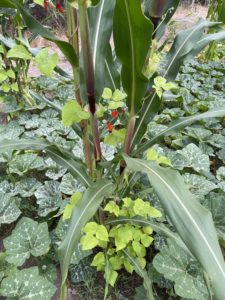 Mother Nature has a refined sense of irony. When I decided to plant a milpa this spring I was looking forward to trying out a planting style that was developed in ancient Mexico. In a milpa, a holy trinity of corn, squash, and beans are cultivated together in harmony. The corn grows upright and its thick stocks serve as a ladder for the beans to climb up and find support in. Meanwhile, the squash plants spread out across the ground and choke out any weeds. Even the weeds common in the milpa that do poke through the canopy of squash, like the wild tomatillos, lambsquarters or purslane, are edible and are appreciated for the variety they add to the diet.
Mother Nature has a refined sense of irony. When I decided to plant a milpa this spring I was looking forward to trying out a planting style that was developed in ancient Mexico. In a milpa, a holy trinity of corn, squash, and beans are cultivated together in harmony. The corn grows upright and its thick stocks serve as a ladder for the beans to climb up and find support in. Meanwhile, the squash plants spread out across the ground and choke out any weeds. Even the weeds common in the milpa that do poke through the canopy of squash, like the wild tomatillos, lambsquarters or purslane, are edible and are appreciated for the variety they add to the diet.
In my milpa I chose to plant a Oaxacan corn, a Japanese runner bean and a French squash. All of these crops had, of course, been essentially developed in Mesoamerica before the “Columbian Exchange” but had then found a new
refinement after being cultivated overseas in different countries. I figured that my multi-cultural milpa would be a fun expression of California’s culinary and human diversity. And I haven’t been disappointed. The French Doran squash have scrambled across the ground and cloaked the soil, choking out weeds. The Japanese Akahana mame beans have twined their way up the stalks of Oaxacan Pinto corn, which reach 10 feet high into the sky. I even planted some sunflowers to brighten the corn patch. Sunflowers are yet another invention of pre-Columbian American farmers. But I wasn’t counting on the turkeys.
In Mexico the word for turkey is “guajolote” and there is no food more essentially Mexican than Mole Poblano, or guajolote served in a mole sauce. And mole sauces typically are made rich and velvety with squash seeds that have been pounded into a paste. The people that invented the milpa, that developed the corn, squash, and beans from wild plants into major crops—these people really knew how to live at home in their environment. Not only did they create a number of the world’s most important food crops, they also knew how to eat the pests that plagued those crops. The corn fungus that disfigured the young ears of corn was considered a delicacy- huitlacoche- and when it presented itself in a crop it was welcomed, not treated with fungicide. The grasshoppers that would eat the young corn were gathered to be cooked up to be served alongside the beans and squash. In an elegant twist of fate the corn earworms that eat young corn and leave a disfiguring pathway through the neat rows of colored kernels were themselves cooked in hot oil and served to hungry diners in corn tortillas. And the wild turkeys that dared to invade the milpa were tamed and domesticated. The ancient farmers that created the milpa system of farming were thrifty and creative. Then there’s me….
The packs of wild turkeys that roam my yard haven’t ruined my milpa but they have made success more of a challenge to achieve. These big, fat birds have pecked some of the squash, devoured the sunflowers, and torn up a lot of the beans by thrashing around in the corn patch taking dust baths. I could solve the problem by shooting the turkeys and serving them in a corn tortilla with a tomatillo de milpa salsa. But I won’t. As much as the turkeys annoy me by stealing cat food from my kitty’s bowls, by crapping all over my yard, and by messing up my garden, I do find them entertaining and puzzling. How can wild turkeys be so stupid and still survive? Everyday they come to the fence as they cross the property and walk back and forth in confusion, forgetting that they know how to fly and in fact have flown over the same fence many times before, even earlier that same morning.
So the turkeys walk back and forth along our fence line dressed in stupid splendor, their plumage flashing their psychedelic, iridescent camouflage that so curiously is flashy yet effective at blending them into the grass. Once the turkeys finally do hop across the fence with a simple flap of the wings they line up at the top of our little slope just south of our house. They like to run down the hill that has become their personal runway to help them with their takeoff, and they make a great, noisy beating of their wings before they catch flight. Overhead the turkeys look like pterodactyls as they fly across the sky, heading to the tops of the tall Torrey pine tree at the foot of the hill. Each turkey selects its own tree limb to land on. After some squawking and gobbling and fluffing of feathers they settle down to sleep. The ground below their roosting tree is littered with turkey crap- and with coyote turds because our sharp-nosed canine companions are always hoping for a turkey dinner.
—© 2021 Essay by Andy Griffin. Photos by Starr Linden
A Pinch of Fresh Seasonal Herb Salt
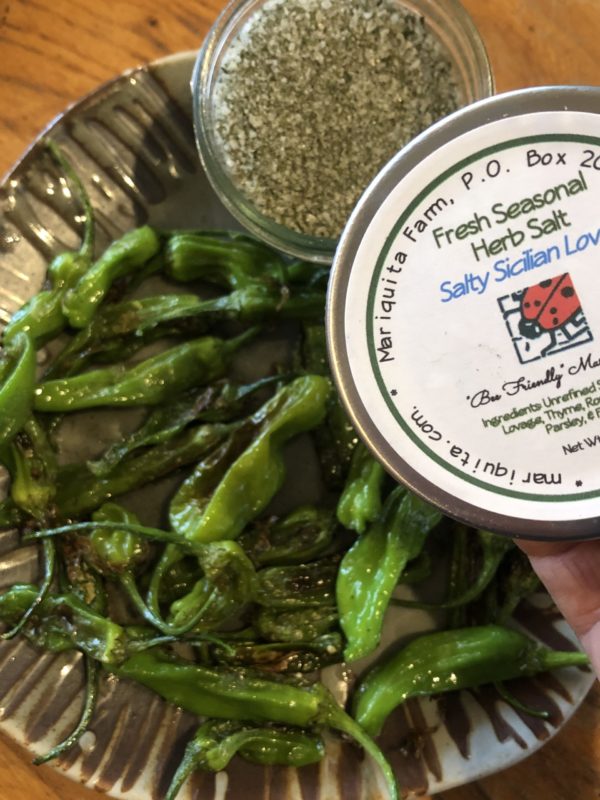
I
Didn’t your mother ever tell you “You can catch more flies with sugar than salt?” Mine didn’t, but I do get the point. If I’m more diplomatic now at 62 than I was at 22, it’s because my naturally salty attitude has been repeatedly humbled by karma and circumstances. Besides; who wants to catch flies? And if salt isn’t any good for catching flies, what is it good for?
Our modern English word “salary,” comes from the Latin word “sal,” for “salt,” and references the “salarium,” or ration of salt that Roman soldiers received for the duration of their military service. Ancient cities, like Salzburg, Austria, were established near the salt mines that were so economically important. It’s not just that a daily measure of salt is essential for our bodies to function. In the ancient world there was no way to refrigerate anything so preserving food often meant drying and salting fresh fruits and vegetables.
Today, we understand that if we overdo our salt intake we can experience some deleterious effects, like high blood pressure. And with electric freezers we aren’t so dependent any more on salt to preserve our foods. But there are still plenty of reasons to employ and enjoy a pinch of salt in the kitchen. In moderation, salt is effective at drawing out flavors from foods and every summer I observe people lightly salting their slices of watermelon.
I prefer to salt my salads. In fact, the word “salad” comes from the Latin “salata,” meaning “salted,” and refers to our human custom of salting the fresh greens we’re going to eat raw. The salt acts to draw a bit of the moisture out of the greens and that contributes to the dressing’s ability to bind the disparate elements of a tossed salad into a piquant, flavorful and cohesive whole. We have added a dash of the herb salt to a pan full of Shishito peppers and lightly salting tomatoes can really “wake them up” in your mouth.
This year, seeing the large supply of fresh herbs that were coming on in our greenhouses, we chose to dry some of our crops and use them to flavor salt. Crops like oregano, thyme, and marjoram need to be repeatedly cut back or harvested so that they stay green and vigorous and don’t become woody and senescent. And we thought we’d have some fun experimenting with some fresh, leafy aromatic herbs like parsley, lovage, and cilantro, too.
For salt we turned to our friends Aaron and Martin. Besides being a professional cook, Aaron represents Marisal, a Mexican cooperative of hand harvested sea salt gatherers in Colima, Mexico. And my friend Martin, besides being a farmer, also sells a range of food products, including his favorite Sicilian sea salt. There are lots and lots of different salts, they range in color, size, texture and moisture levels and the two we chose are different from each other in terms of crystal shape and size so we played around with them for a while and we hope you will too.
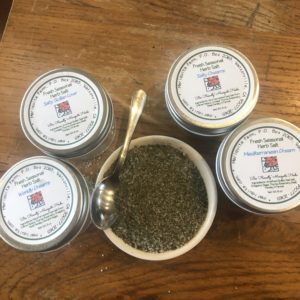 Choose from two sets of two Mariquita Fresh Seasonal Herb Salts.
Choose from two sets of two Mariquita Fresh Seasonal Herb Salts.
The first set:
“Salty Dreams” contains sea salt from Colima, Mexico infused with Lovage, Thyme, Rosemary, Basil, Parsley and Fennel.
“Mediterranean Dream” contains sea salt from Sicily, Italy, a Sea Salt infused with Oregano, Sage, Thyme, Rosemary, Basil, Parsley and Fennel.
The second set:
“Worldly Dreams” contains sea salt from Colima, Mexico infused with Oregano, Sage, Thyme, Rosemary, Basil, Parsley and Fennel.
“Salty Sicilian Love” contains sea salt from Sicily, Italy infused with Lovage, Thyme, Rosemary, Basil, Parsley and Fennel.
You can find our herbal sea salt selections on the farm shop pages. The variety of Mariquita blended herbs adds a nice touch to the salt and will enhance a wide variety of foods. Use as a seasoning for salads, soups, roasts and fish. We even love it on our popcorn!
Enjoy,
Your Friends at Mariquita Farm
—© 2021 Essay by Andy Griffin. Photos by Starr Linden
~Special Note~
As the weather is getting warmer, the sun is rising earlier and the harvesting begins with the sunrise, we will be closing our East Bay/Peninsula shop by 6 PM on the Wednesday evenings before the Friday delivery. We close our San Francisco & Mystery Thursday shops on Wednesday mornings by 8 AM and our Santa Cruz/Los Gatos shop by 8 AM, on Monday mornings. Please get your orders in early so you don’t miss out on the harvest! Thank you all again for being such a part of our bountiful farm!
If you haven’t ordered a Mystery Box recently, now is a great time to get in on spring deliciousness! LadybugBuyingClub
Enjoy the August Harvest
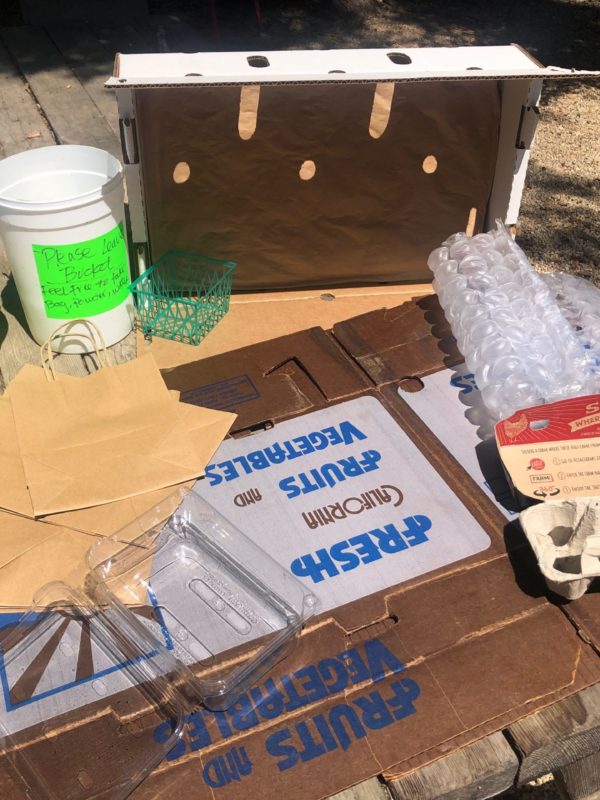
In his effort to liberate India from the British Empire Mohandas Gandhi employed effective political tactics based on principles of non-violence. A generation later, in the United States, the Reverend Martin Luther King preached a strategy of non-violence as he challenged systemic racism and a culture of war. Some people question the wisdom of non-violent political action and ask, “Can pacifism work when peaceful idealists challenge political actors, like Hitler, who have no problem murdering their opponents?” It’s an interesting question but beyond the scope of today’s newsletter. Instead, I’d like to talk about recycling. That said, I assure you that non-violence provides a simple, effective and satisfying approach to employ when opening and closing the waxed cartons that we deliver our produce in. Sometimes when I’m sorting through the re-used cartons I’m shocked at how torn up some of them are- as though wolverines mangled them. It doesn’t have to be that way.
The boxes we use to ship our produce in cost north of $1.75 per carton. When we are able to use the boxes over and over again that $1.75 is amortized over the multiple uses. Each virgin box comes with creases stamped into the cardboard to ease in the folding and unfolding process. Nothing needs to be torn for a box to be successfully opened or closed. To open a box non-violently, just observe where the crease is on the tabs that form the lid of the box and draw back with a pinching motion to free the tabs from the slots in the lid they’ve been pressed into to close and secure the lid. Voila!
To fold the empty cartons up for easy storage simply invert the empty box, observe the crease in the tabs that close and secure the bottom of the box and press them back to unlock the carton. With the top and bottom open the box simply folds up. Stacking the empty, folded cartons, helps keep the pick-up sites presentable and clean. We can save thousands of dollars if we can reuse the cartons many times. Ruined boxes cost money since we have to gather up the damaged cartons and then take them to the dump. They are waxed and therefore, not recyclable in Santa Cruz County. And new boxes keep climbing in price. The paraffin used to “wax” the waxed cartons comes from petroleum so carton costs are tied to the price of oil. Have you noticed how much it costs to fill up a gas tank these days? Paper isn’t getting cheaper either.
Recycling isn’t just good economics- it’s also a gesture of respect to the planet that sustains us. At Mariquita Farm we’re doing whatever we can to avoid wasting resources and we recycle what we can. Please read our list because we cannot take back all the recycling in your home, just the items we can reuse. Here’s a list of what we can re-use. And let us remind you we cannot take back items that are dirty or soiled.
IMPORTANT: Please stack the boxes neatly and leave all other returned items in a tidy manner in the crates at the site. Our hosts have invited us to use their homes and businesses as produce drop spots but we can’t turn them into unauthorized recycling centers.
List of Items we can re-use at Mariquita Farm:
- The full or half strawberry cartons and green plastic baskets that we ship cherry tomatoes in.
2. The white or brown tomato boxes we ship Early Girl tomatoes in. Please return the empty tomato boxes without unfolding them, as they stay stronger for re-use that way. They must be clean and unsoiled.
3. The plastic clamshells that we put tomatoes and sometimes peppers or other items in. Please do not send us clamshells that you receive from other places. We have one size only. They must be clean and unsoiled.
4. If you purchase flowers do not take the container they arrive in. Each bouquet has a plastic bag attached that can be used to transport flowers home in, if needed, and powder which will help prolong their beauty once you put them in a vase.
5. We can always use clean brown paper grocery bags and if you want to recycle the smaller handled bags that your side products from us come in you may also leave them in the crate.
6. We will take egg cartons if they came from us; do not send us egg cartons unless you bought them from us.
7. Lastly, we cannot take back plastic bags of any kind. Please find other ways to use them at home.
Thank you so much for making an effort to reuse these items. Not only will it keep the costs down but also it will save resources for all.
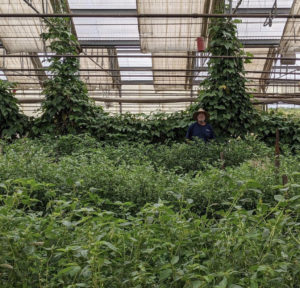 Now back to food, which is what we love to talk about the most. Strawberries make a comeback this week after the birds harvested them last week. Tomatoes are here to stay for a while. At the market customers sometimes ask, “Why are they called “dry farmed?” They look shocked when we tell them that they were transplanted into moist soil but not given any additional water the entire time they are growing. These plants send their roots deep into the mineral earth to find water. The minerals and trace elements found in the deeper soil result in the great tomato flavor you get when you pop one in your mouth or slice one onto a salad. These days our meals are filled with tomato salads and Shishito pepper appetizers. Pan fry a few shishito peppers in Marguerite’s Olive oil and sprinkle with a bit of our herb salt and you have a very good tasty treat.
Now back to food, which is what we love to talk about the most. Strawberries make a comeback this week after the birds harvested them last week. Tomatoes are here to stay for a while. At the market customers sometimes ask, “Why are they called “dry farmed?” They look shocked when we tell them that they were transplanted into moist soil but not given any additional water the entire time they are growing. These plants send their roots deep into the mineral earth to find water. The minerals and trace elements found in the deeper soil result in the great tomato flavor you get when you pop one in your mouth or slice one onto a salad. These days our meals are filled with tomato salads and Shishito pepper appetizers. Pan fry a few shishito peppers in Marguerite’s Olive oil and sprinkle with a bit of our herb salt and you have a very good tasty treat.
Enjoy the August harvest!
Your friends at Mariquita Farm
—© 2021 Essay by Andy Griffin. Photos by Starr Linden
~Special Note~
As the weather is getting warmer, the sun is rising earlier and the harvesting begins with the sunrise, we will be closing our East Bay/Peninsula shop by 6 PM on the Wednesday evenings before the Friday delivery. We close our San Francisco & Mystery Thursday shops on Wednesday mornings by 8 AM and our Santa Cruz/Los Gatos shop by 8 AM, on Monday mornings. Please get your orders in early so you don’t miss out on the harvest! Thank you all again for being such a part of our bountiful farm!
If you haven’t ordered a Mystery Box recently, now is a great time to get in on spring deliciousness! LadybugBuyingClub
Wild Life
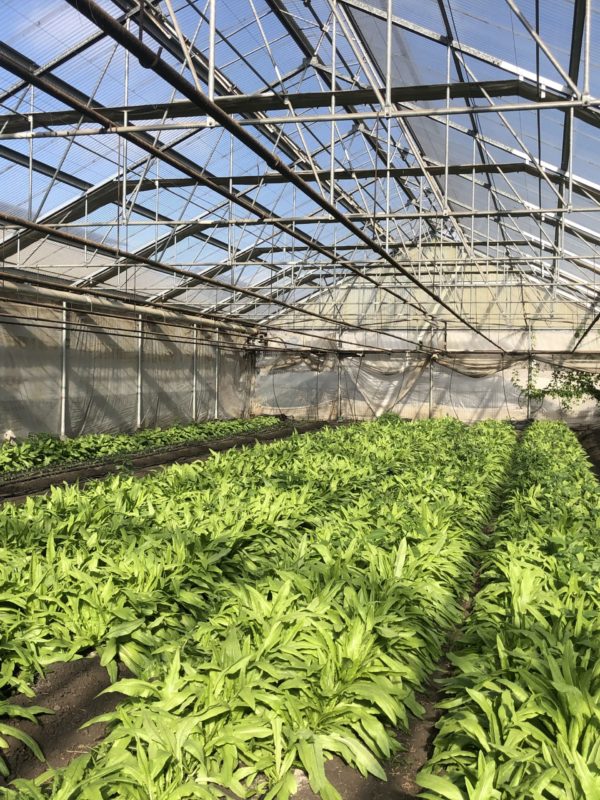
“Back in the day,” as in “back in my great-grandfather’s day,” Watsonville was a “dry town.” A traveler heading on the dirt road out of town, bound for Santa Cruz didn’t need a road sign to tell them they’d reached the city limits because they had the swinging doors of the Whiskey Hill Saloon just over the line welcoming them to the unincorporated county territory. And five miles down the dirt road from Whiskey Hill through the apple orchards that carpeted the area was the first stage stop, a rustic roadhouse appropriately called “The Five Mile House.” Think of it as a 19th century truck stop/convenience store. There was hay and water for the teams of horses and mules and food and drink for the teamsters and travelers.
Except for drought and a persistent overdraft of our aquifer, Watsonville is hardly “dry” these days. I’m farming in a greenhouse complex just down the blacktop highway from the Five Mile House, which in its present day incarnation hosts Blossom’s Farm, a biodynamic cafe and boutique, plus a Mexican restaurant, and a tattoo parlor. Watsonville isn’t five miles away any longer either- it’s more like two miles through the fields from our greenhouse to the Quik Stop and first homes of town. Over the years most of the apple orchards in the Pajaro Valley have been cut down and replaced with strawberries or raspberries, but our little neighborhood still smells like apples in the fall from all the fruit on the ground. It still feels like we’re in the country, not the suburbs, and we have wildlife to deal with.
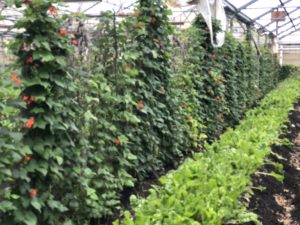 The roof and walls of the greenhouse offer our crops shelter from the weather but they also shelter some critters The same plastic skin that filters the direct sunlight and gives the plants a luxurious, semi-tropical ambiance to thrive in also keeps the hawks and owls from doing their predators’ day and night vigilance, so any rabbits or squirrels that can make it inside have a safe space to munch on lettuces. Yes, I read The Tale of Peter Rabbit to my children when they were young, and I enjoyed the story just as much as they did, and I enjoyed it just as much as I had when my mother read it to me as a child, but I have to admit that as an adult- and a farmer- my sympathies are definitely with Mr. McGregor so the tale is more morally nuanced than it once seemed.
The roof and walls of the greenhouse offer our crops shelter from the weather but they also shelter some critters The same plastic skin that filters the direct sunlight and gives the plants a luxurious, semi-tropical ambiance to thrive in also keeps the hawks and owls from doing their predators’ day and night vigilance, so any rabbits or squirrels that can make it inside have a safe space to munch on lettuces. Yes, I read The Tale of Peter Rabbit to my children when they were young, and I enjoyed the story just as much as they did, and I enjoyed it just as much as I had when my mother read it to me as a child, but I have to admit that as an adult- and a farmer- my sympathies are definitely with Mr. McGregor so the tale is more morally nuanced than it once seemed.
At dawn, when we show up to work the dusty driveways in between the rows of greenhouses that make up the 15 acre complex show a variety of tracks that act as a visitors log for all the nighttime activity. We keep the greenhouse doors tight against any intruders, but there are always raccoon tracks and possum’s tracks. There’s a drain ditch dividing our green houses from the neighboring orchard, which the critters use as a veritable highway. The raccoons would like for nothing more than to remove burrito wrappers from the garbage can in the lunch area and lick the grease and beans from the foil before washing their hands in the ditch water. But neither they, not the possums, do much damage because they’re not that crazy about greens.
Sometimes we’ll see Blue Herons or Snowy Egrets hunting frogs in the ditch. I’m sad for the frogs, but I like to see these beautiful birds hunting. Besides frogs from the ditch, they’ll also eat gophers in the orchards. Gophers migrate under ground and can move miles over time, out of the orchard, under the ditch, under the dirt access road, under the green house walls, and into our plantings, so they’re bad news.
One morning I showed up just in time to see Miss Coyote slip past the water tank and trot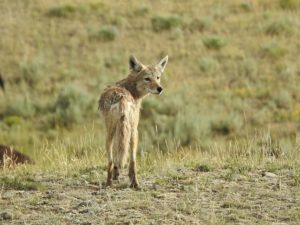 down the alley between two green houses with her nose to the ground following a jack rabbit’s trail. I wished her success. And another morning I was surprised to see a little ferret emerge from a hole under the greenhouse wall and dart into a pile of pallets. Ferrets may be illegal as pets because they’re not native species and they rob songbirds’ nests of eggs, but I welcome them because they are relentless against rats, mice, and baby rabbits and squirrels.
down the alley between two green houses with her nose to the ground following a jack rabbit’s trail. I wished her success. And another morning I was surprised to see a little ferret emerge from a hole under the greenhouse wall and dart into a pile of pallets. Ferrets may be illegal as pets because they’re not native species and they rob songbirds’ nests of eggs, but I welcome them because they are relentless against rats, mice, and baby rabbits and squirrels.
And then there are people to worry about. There’s a cyclone fence with barbed wire and a padlock on the gate that faces what is now a busy highway to help keep out unwelcome human visitors. Because so many local green houses are given over to marijuana cultivation these days we need to keep the place almost hermetically sealed as there are always strangers wanting to enter to see if there’s any weed to steal.
The fence doesn’t enclose the drain ditch though, so we do get people walking back from the highway to investigate what we’re doing. And after 40 years of “Trickle down economics,” there are lots of homeless people in our area, just as there are in the big cities. There have been camps that sprang up back in the shelter of the orchard where the people couldn’t be seen. Some of these homeless folks are actually employed as farmworkers but can no longer pay their rents. We have come to expect to find the toilet paper to be taken from our porta potty from time to time. Sometimes people have broken into the greenhouses and taken harvest knives, hats, water bottles, and ice chests- even the bottles of hot sauce that the crew had left by the table in expectation of the next day’s lunch.
What’s the moral of the story?
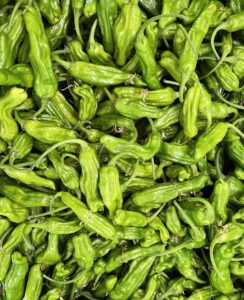 Time marches on and life on the farm is full of surprises. Luckily we have shishito peppers to enjoy flowing from the green houses now. They’re very easy to prepare. One way I like to cook them is to heat up a cast iron skillet and add just enough cooking oil to cover the bottom. Then toss a handful of peppers in- not so many that they cover the pan. Let the peppers toast until browned on one side and turn them. It shouldn’t take long. Then, with a sprinkle of salt you’re good to go. If you put too many peppers in at once they’ll tend to steam, not fry quickly; they’d still be good, but just not the same. The cooking time for the pan fried shishitos is so quick you’ll be able to make a second batch fast before your dinner guests eat them and before you have a chance to enjoy any. If the raccoons ever figure out how to fire up the little camp stove the crew uses to warm their tortillas for lunch we’ll have a real problem in the pepper patch! They know good food when they find it!
Time marches on and life on the farm is full of surprises. Luckily we have shishito peppers to enjoy flowing from the green houses now. They’re very easy to prepare. One way I like to cook them is to heat up a cast iron skillet and add just enough cooking oil to cover the bottom. Then toss a handful of peppers in- not so many that they cover the pan. Let the peppers toast until browned on one side and turn them. It shouldn’t take long. Then, with a sprinkle of salt you’re good to go. If you put too many peppers in at once they’ll tend to steam, not fry quickly; they’d still be good, but just not the same. The cooking time for the pan fried shishitos is so quick you’ll be able to make a second batch fast before your dinner guests eat them and before you have a chance to enjoy any. If the raccoons ever figure out how to fire up the little camp stove the crew uses to warm their tortillas for lunch we’ll have a real problem in the pepper patch! They know good food when they find it!
—© 2021 Essay by Andy Griffin. Photos of greenhouses and shishito peppers by Andy Griffin and picture of Coyote by Pixabay
~Special Note~
As the weather is getting warmer, the sun is rising earlier and the harvesting begins with the sunrise, we will be closing our East Bay/Peninsula shop by 6 PM on the Wednesday evenings before the Friday delivery. We close our San Francisco & Mystery Thursday shops on Wednesday mornings by 8 AM and our Santa Cruz/Los Gatos shop by 8 AM, on Monday mornings. Please get your orders in early so you don’t miss out on the harvest! Thank you all again for being such a part of our bountiful farm!
If you haven’t ordered a Mystery Box recently, now is a great time to get in on spring deliciousness! LadybugBuyingClub
A Sunday Adventure
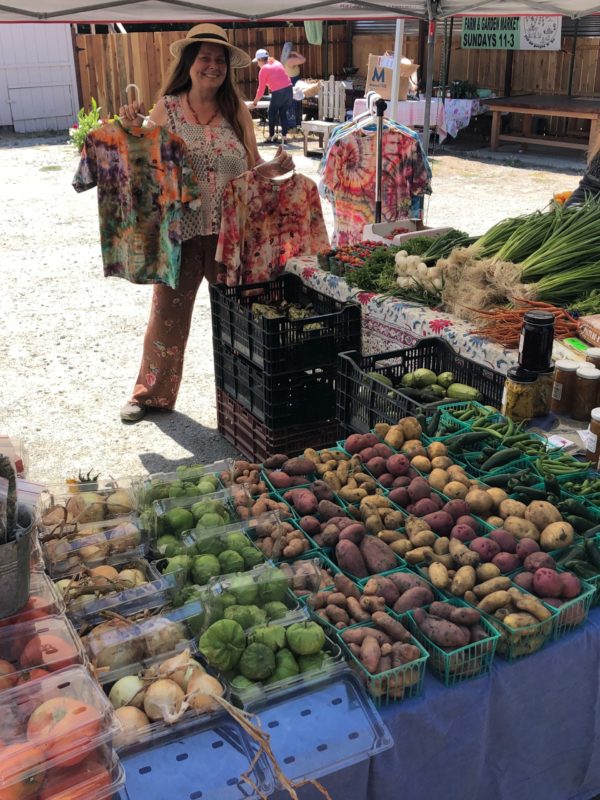
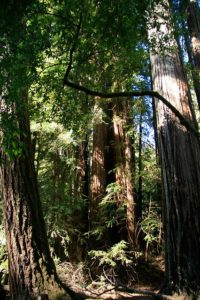 We still have redwoods here, especially in the canyons, but the old growth trees that carpeted the valley are gone. When the Spanish king granted the Amesti family a ranch here, the 14,000 acre parcel was called Rancho Corralitos. Both my home ranch and the greenhouse facility I lease are on lands that were once part of the Rancho Corralitos. When Don Amesti, the Rancho Corralitos landlord, saw fit to lease his property to some German loggers in the 1840s, our little valley became the first place in California for commercial redwood logging. Once the big trees were gone our neighborhood slipped into obscurity until 1905 when the San Francisco earthquake and fire prompted the logging of the second growth redwoods that were needed to rebuild the City.
We still have redwoods here, especially in the canyons, but the old growth trees that carpeted the valley are gone. When the Spanish king granted the Amesti family a ranch here, the 14,000 acre parcel was called Rancho Corralitos. Both my home ranch and the greenhouse facility I lease are on lands that were once part of the Rancho Corralitos. When Don Amesti, the Rancho Corralitos landlord, saw fit to lease his property to some German loggers in the 1840s, our little valley became the first place in California for commercial redwood logging. Once the big trees were gone our neighborhood slipped into obscurity until 1905 when the San Francisco earthquake and fire prompted the logging of the second growth redwoods that were needed to rebuild the City.Farm & Garden Market
Corralitos Cultural Center 127 Hames Road, Corralitos, CA Sunday, 11AM to 3PM
—© 2021 Essay by Andy Griffin and photos by Andy Griffin
Photo of Redwoods by Pixabay
~Special Note~
As the weather is getting warmer, the sun is rising earlier and the harvesting begins with the sunrise, we will be closing our East Bay/Peninsula shop by 6 PM on the Wednesday evenings before the Friday delivery. We close our San Francisco & Mystery Thursday shops on Wednesday mornings by 8 AM and our Santa Cruz/Los Gatos shop by 8 AM, on Monday mornings. Please get your orders in early so you don’t miss out on the harvest! Thank you all again for being such a part of our bountiful farm!
If you haven’t ordered a Mystery Box recently, now is a great time to get in on spring deliciousness! LadybugBuyingClub
Shedding Light on the Nightshade Family
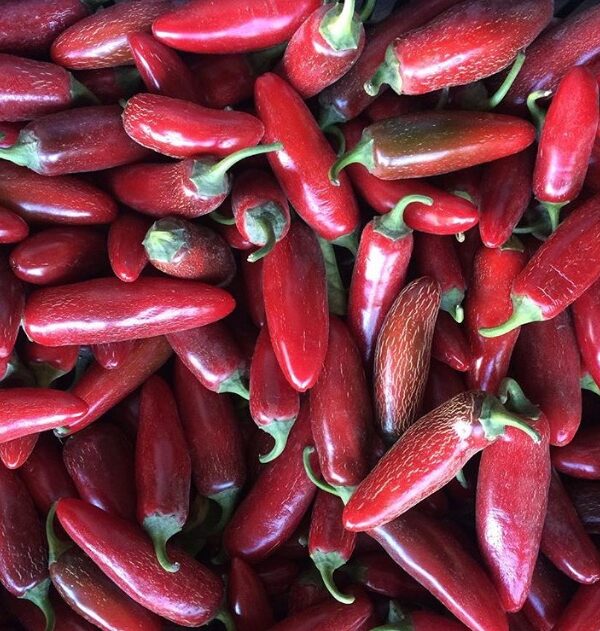
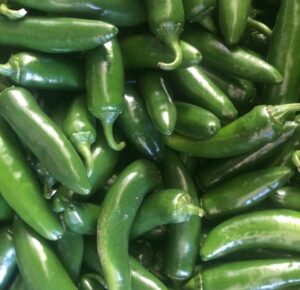 I have never been to Jalapa. I don’t even know any Jalapeños, but I know their peppers. The Jalapeño pepper is one of the most widely adapted pepper varieties across continents and cultures. Smoked jalapeños, or “Chipotles,” are essential in Mexican cuisine. Red, mature Jalapeños are an essential ingredient in Sriracha. Jalapeños put the “pop!” in “poppers,” the food truck favorite that finds the green, bullet shaped peppers stuffed with cheese, then dipped in cornmeal batter and deep fried. Jalapeños are natural in fresh salsas, minced well into ceviche, and add a sting when sliced finely into Thai coconut milk based soups. What’s not to love?
I have never been to Jalapa. I don’t even know any Jalapeños, but I know their peppers. The Jalapeño pepper is one of the most widely adapted pepper varieties across continents and cultures. Smoked jalapeños, or “Chipotles,” are essential in Mexican cuisine. Red, mature Jalapeños are an essential ingredient in Sriracha. Jalapeños put the “pop!” in “poppers,” the food truck favorite that finds the green, bullet shaped peppers stuffed with cheese, then dipped in cornmeal batter and deep fried. Jalapeños are natural in fresh salsas, minced well into ceviche, and add a sting when sliced finely into Thai coconut milk based soups. What’s not to love?
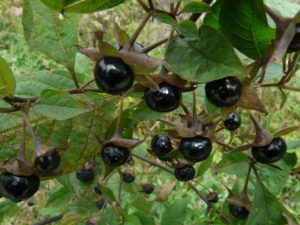 the Solanacea family to the eggplants, peppers, tomatoes etc. Unlike its more commercial cousins, Atropa belladonna, also known as “Deadly Nightshade,” is native to Europe, Africa, and Asia. The nightshade’s little, black berries look like “Goth Cherry tomatoes.” The lavender flowers of poisonous nightshade look like potato flowers. And significantly, the powerful alkaloids that the nightshade berries contain can provoke delirium and hallucinations when ingested in moderation. If you consume Belladonna “immoderately” then you die. Not everybody in old world Europe hung on to the Pope’s every word with fascination; there were witches, for example, whose spiritual path took them far from the catechism of the Patriarchy, and some of them chose to trip on Belladonna. This association gave all nightshade family lookalikes a sinister, diabolic reputation.
the Solanacea family to the eggplants, peppers, tomatoes etc. Unlike its more commercial cousins, Atropa belladonna, also known as “Deadly Nightshade,” is native to Europe, Africa, and Asia. The nightshade’s little, black berries look like “Goth Cherry tomatoes.” The lavender flowers of poisonous nightshade look like potato flowers. And significantly, the powerful alkaloids that the nightshade berries contain can provoke delirium and hallucinations when ingested in moderation. If you consume Belladonna “immoderately” then you die. Not everybody in old world Europe hung on to the Pope’s every word with fascination; there were witches, for example, whose spiritual path took them far from the catechism of the Patriarchy, and some of them chose to trip on Belladonna. This association gave all nightshade family lookalikes a sinister, diabolic reputation.—© 2021 Essay by Andy Griffin and photos of jalapeños by Andy Griffin
Photo of Belladona by Pixabay
~Special Note~
As the weather is getting warmer, the sun is rising earlier and the harvesting begins with the sunrise, we will be closing our East Bay/Peninsula shop by 6 PM on the Wednesday evenings before the Friday delivery. We close our San Francisco & Mystery Thursday shops on Wednesday mornings by 8 AM and our Santa Cruz/Los Gatos shop by 8 AM, on Monday mornings. Please get your orders in early so you don’t miss out on the harvest! Thank you all again for being such a part of our bountiful farm!
If you haven’t ordered a Mystery Box recently, now is a great time to get in on spring deliciousness! LadybugBuyingClub
The Tomatoes are Coming
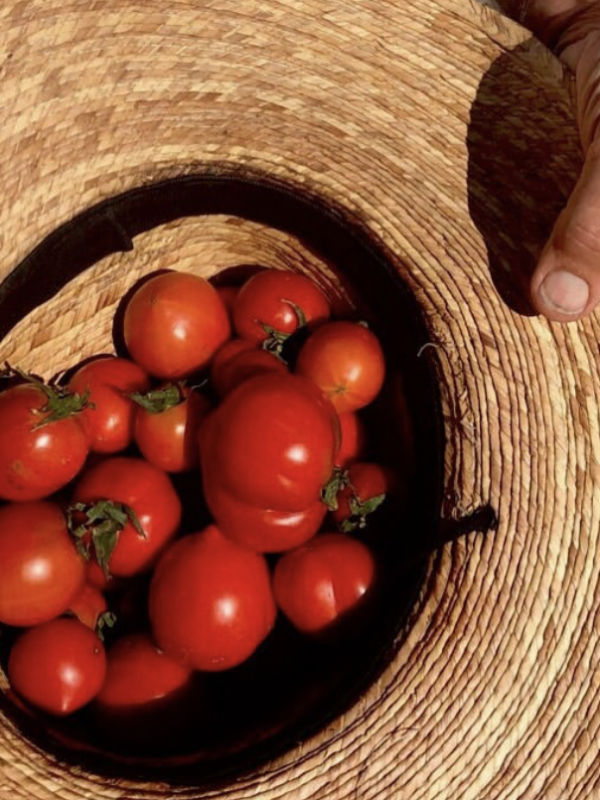
People have been asking when the dry-farmed Early Girl tomatoes and San Marzano tomatoes will be available in bulk for canning.
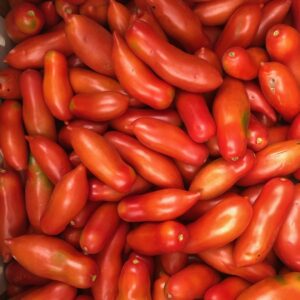 Every year is different because the weather conditions that push or stall the crop vary, but we always plant our tomatoes after the 15th of April and we usually have a nice supply of ripe fruit by late July. Cherry tomatoes are small and ripen quickly so they come first. Early Girls are called “Early” because they are quicker to ripen than some other varieties. San Marzano tomatoes have many virtues, including a rich, thick texture when they’re cooked down into sauce but they’re not “early.” It’s a lot of work to plant out the tomatoes in the spring and we can’t complete the entire task at once, so typically we plant the different varieties out in stages over several weeks. I figure that we’ll have a supply of San Marzano tomatoes starting in mid-August.
Every year is different because the weather conditions that push or stall the crop vary, but we always plant our tomatoes after the 15th of April and we usually have a nice supply of ripe fruit by late July. Cherry tomatoes are small and ripen quickly so they come first. Early Girls are called “Early” because they are quicker to ripen than some other varieties. San Marzano tomatoes have many virtues, including a rich, thick texture when they’re cooked down into sauce but they’re not “early.” It’s a lot of work to plant out the tomatoes in the spring and we can’t complete the entire task at once, so typically we plant the different varieties out in stages over several weeks. I figure that we’ll have a supply of San Marzano tomatoes starting in mid-August.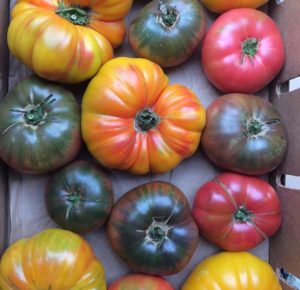 This week we’re starting in on the earliest heirloom tomatoes. Of all of the varieties they’re the most vulnerable to extreme heat and sunscald, so I’m hoping the temps are moderate over the coming weeks. So far so good- the first fruit is always buried in green foliage and protected from the direct rays of the sun. I hope you are too, and I’m hoping you’re as hungry for fresh salsa and Caprese salad as I am.
This week we’re starting in on the earliest heirloom tomatoes. Of all of the varieties they’re the most vulnerable to extreme heat and sunscald, so I’m hoping the temps are moderate over the coming weeks. So far so good- the first fruit is always buried in green foliage and protected from the direct rays of the sun. I hope you are too, and I’m hoping you’re as hungry for fresh salsa and Caprese salad as I am.—© 2021 Essay by Andy Griffin and photos of farm by Andy Griffin
~Special Note~
As the weather is getting warmer, the sun is rising earlier and the harvesting begins with the sunrise, we will be closing our East Bay/Peninsula shop by 6 PM on the Wednesday evenings before the Friday delivery. We close our San Francisco & Mystery Thursday shops on Wednesday mornings by 8 AM and our Santa Cruz/Los Gatos shop by 8 AM, on Monday mornings. Please get your orders in early so you don’t miss out on the harvest! Thank you all again for being such a part of our bountiful farm!
If you haven’t ordered a Mystery Box recently, now is a great time to get in on spring deliciousness! LadybugBuyingClub
